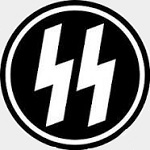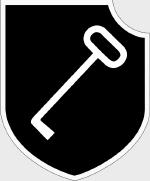Hobby Master HG4606 German Sd. Kfz. 121 PzKpfw II Ausf. F Light Tank - "White 21", Panzer Regiment 5, 1.SS Panzer Grenadier Division, Kharhov, Russia, 1943 (1:72 Scale)
"If the tank succeeds, then victory follows."
- Major-General Heinz Guderian, "Achtung Panzer!"
 Originally identified as the '2cm MG Panzerwagen', the PzKpfw II light tank was designed to supplement the PzKpfw I by providing an automatic weapon capable of firing both a high explosive round and an armor piercing round. The design period was very short: the initial order for a tank design in the 10-ton class was issued by the Waffenamt in July 1934, and the first complete soft steel prototype was put through its paces in October 1935. Unfortunately, many of the teething problems had not been worked out when rapid expansion of the panzerwaffe and international politics forced the decision to order a comparatively large number of PzKpfw IIs. First issued to Panzer units in the spring of 1936, the PzKpfw II was armed with a 2cm KwK L/55 gun and was crewed by three men.
Originally identified as the '2cm MG Panzerwagen', the PzKpfw II light tank was designed to supplement the PzKpfw I by providing an automatic weapon capable of firing both a high explosive round and an armor piercing round. The design period was very short: the initial order for a tank design in the 10-ton class was issued by the Waffenamt in July 1934, and the first complete soft steel prototype was put through its paces in October 1935. Unfortunately, many of the teething problems had not been worked out when rapid expansion of the panzerwaffe and international politics forced the decision to order a comparatively large number of PzKpfw IIs. First issued to Panzer units in the spring of 1936, the PzKpfw II was armed with a 2cm KwK L/55 gun and was crewed by three men.
Pictured here is a 1:72 scale replica of a German Sd. Kfz. 121 PzKpfw II Ausf. F Light Tank that was attached to Panzer Regiment 5, 1.SS Panzer Grenadier Division, then deployed to Kharhov, Russia, during 1943.
Sold Out!
Dimensions:
Length: 2-1/2-inches
Width: 1-1/4-inches
Release Date: June 2013
 Historical Account: "Normandiefront" - SS-Panzer Division Leibstandarte Adolf Hitler (LAH) was formed on March 17th, 1933, by Josef "Sepp" Dietrich, Hitler's bodyguard, on the order of der Fuhrer who wanted a full-time armed force that was completely loyal to him. It was attached to Heeresgruppe Sud during the invasion of Poland and later took part in the invasion of France and the Low Countries. For the most part LAH was held in reserve although it was employed against retreating British troops trapped at Dunkirk. After the British capitulation, it was attached to XIV Armeekorps during the second and final phase of the invasion of France.
Historical Account: "Normandiefront" - SS-Panzer Division Leibstandarte Adolf Hitler (LAH) was formed on March 17th, 1933, by Josef "Sepp" Dietrich, Hitler's bodyguard, on the order of der Fuhrer who wanted a full-time armed force that was completely loyal to him. It was attached to Heeresgruppe Sud during the invasion of Poland and later took part in the invasion of France and the Low Countries. For the most part LAH was held in reserve although it was employed against retreating British troops trapped at Dunkirk. After the British capitulation, it was attached to XIV Armeekorps during the second and final phase of the invasion of France.
Following the armistice, LAH was upgraded to a brigade and began training for the planned invasion of Britain (Operation
Seelowe). When the invasion was cancelled, LAH was transferred to Romania for the Balkan invasion.
It fought its way through Yugoslavia and Greece chasing Allied troops to Kalamata, where they were evacuated by sea to Crete. LAH was attached to
Heeresgruppe Sud during the initial stages of Operation Barbarossa, seeing action at Kiev and again at the Black Sea port of Rostov. It was transferred to France for refitting in 1942 and was upgraded again, this time to a Panzergrenadier Division. It returned to the Eastern front the following year, fighting at Kharkov and then at Kursk during Operation Zitadelle. After Kursk, LAH was sent to Italy to perform anti-partisan duties but was soon returned to the Eastern front, this time as a full-fledged Panzer Division. Following the debacle at Kamenets-Podolsk, it was sent to France for rest and refit.
LAH fought in Normandy following the Allied invasion and saw action at Caen, Falaise, and Aachen as it fell back on the German frontier. It participated in the Ardennes counteroffensive (Operation "
Wacht am Rhein") where it was attached to I SS Panzerkorps. Later on, LAH was sent back to the Eastern front to help break the siege of Budapest (Unternehmen Margarethe). Afterwards, it was transferred to Austria where it surrendered to American troops at war's end.





 Nice tweak for the Pz II
Nice tweak for the Pz II 


